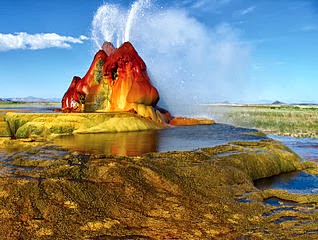New research upholds theoretical structure for cyanobacteria carboxysomes.
The Science
Researchers described the structure of a protein critical to the outer shell of carboxysomes, the organelle-like structure that cyanobacteria use for carbon fixation.
The Impact
The structure and interaction of the proteins that make up the carboxysome’s outer shell aren’t clearly understood. A detailed study of the structure of the Ccml protein – thought to cap the corners of the outer shell – has revealed that it has a five-sided pentamer shape, clearing up debate confirming what researchers have conjectured about its form.
Summary

Cyanobacteria are responsible for the vibrant colors of Fly Geyser, located in the Black Rock Desert, Nevada.
Image by Jeremy C. Munns, via Wikimedia Commons
Cyanobacteria, or blue-green algae, get their energy from photosynthesis, but without the organelles of more advanced eukaryotic cells, they rely on a boxy-looking microcompartment called the carboxysome increases the efficiency of carbon-fixing proteins, such as RuBisCo. The exact shape and structure of one of the proteins, Ccml, that makes up the outer shell has remained elusive. Researchers believe that Ccml maintains a pentameric shape that caps the corners of the icosahedral-shaped outer shell, surrounded by a sea of six-sided hexameric proteins. But previous findings have shown contradictory results about the shape, making it difficult to assess its role in how the outer shell worked.
In a study published online in the journal, Photosynthesis Research, including groups from the DOE Joint Genome Institute, UC Berkeley’s Department of Plant and Microbial Biology and the Berkeley Synthetic Biology Institute, researchers determined that the crystal structure for the Ccml protein for two thermophilic cyanobacteria, Thermosynechococcus elongatus and Gloeobacter violacteus. When the research team studied the genomes of over 100 cyanobacteria species for the amino acids they coded, they found that the Ccml protein retained its pentameric shape.
This finding supports the hypothesis that pentameric proteins sit on the corners of carboxysomes, connecting the facets. Researchers still don’t understand how it interacts with other carboxysome shell proteins and an analysis of the crystal structure of the entire outer shell would be needed to clarify how individual proteins connect to each other.
This project involved an innovative partnership between DOE national user facilities, combining the genome sequencing and sequencing expertise at the DOE Joint Genome Institute with the protein characterization skills of scientists at the Advanced Light Source, both under the auspices of Lawrence Berkeley National Laboratory.
Contact
Cheryl A. Kerfeld
DOE Joint Genome Institute
[email protected]
Sam Deutsch
DOE Joint Genome Institute
[email protected]
Funding
DOE Office of Science, Basic Energy Sciences; Office of Biological and Environmental Research
National Science Foundation
Swiss National Science Foundation
Publication
Sutter M et al, Two new high-resolution crystal structures of carboxysome pentamer proteins reveal high structural conservation of CcmL orthologs among distantly related cyanobacterial species. Photosynth Res. 2013 Aug 15.
DOI 10.1007/s11120-013-9909-z
Related links
http://link.springer.com/article/10.1007%2Fs11120-013-9909-z